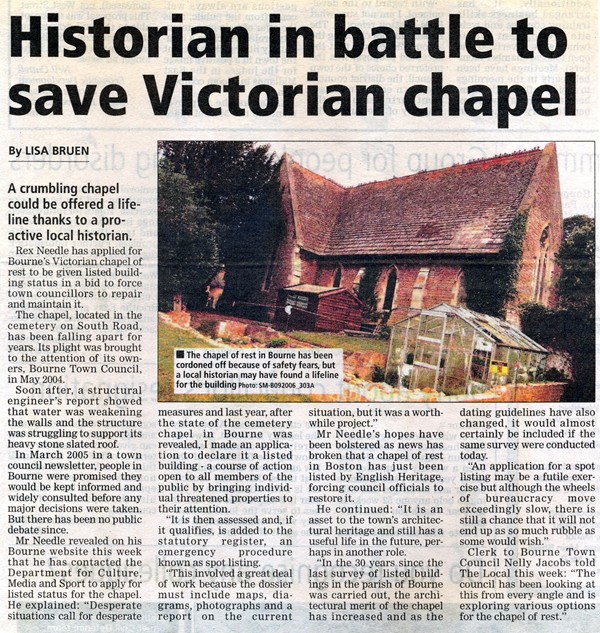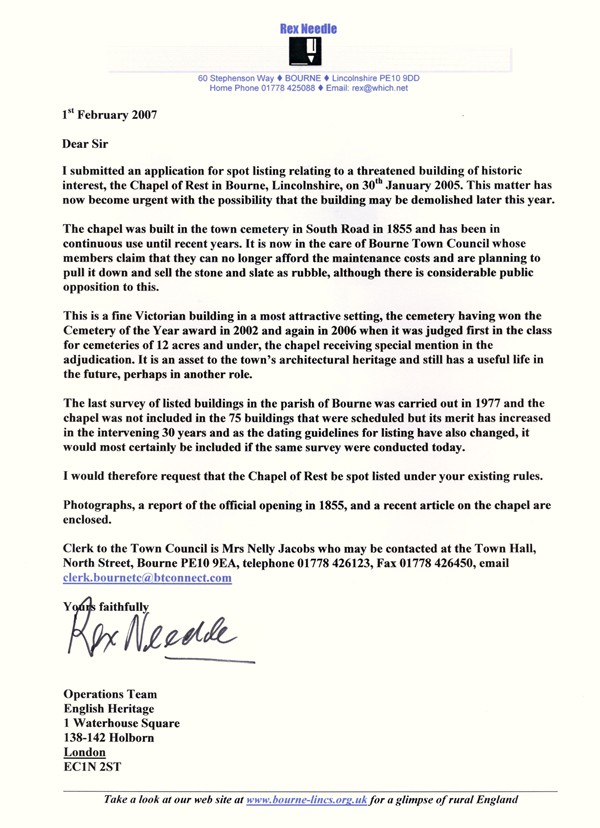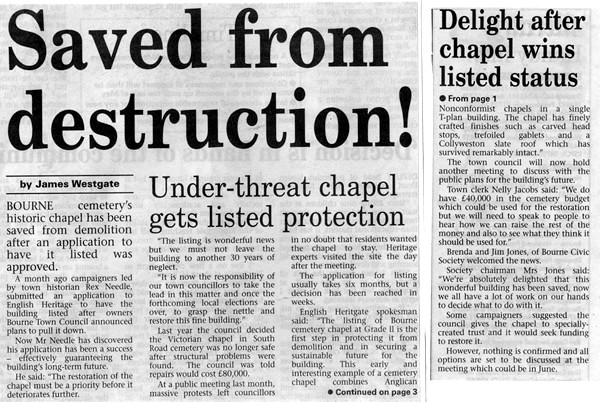|
THE CHAPEL OF REST in the town cemetery was listed a Grade II building of
special architectural and historic interest by the Department of Culture, Media
and Sport (DCMS) following an application by local historian Rex Needle. It was
originally submitted in 2005 but fast-tracked in 2007 when it was
revealed that Bourne Town Council planned to demolish the building and took immediate effect from Wednesday 4th April 2007. The
decision was taken under the Planning (Listed Buildings and Conservation Areas)
Act 1990 on the advice of English Heritage after an assessment by their adviser,
Dr Dale Dishon, assisted in her researches by Mr Needle who provided documents
and photographs to support the application. The following are extracts from the list entry and the
Adviser's Report:
CONTEXT
An application to spot-list this building was originally submitted in January
2005 but was lost during the transfer of responsibility from DCMS to EH. The
application has now been resubmitted as a matter of urgency since Bourne Town
Council, which owns the building, has voted to demolish it. The chapel was
deconsecrated in December 2004 and is being used for storage.
HISTORY
The Burial Act of 1853 authorised the provision of publicly-funded cemeteries
across the country. This ushered in a boom in the construction of public
cemeteries by Burial Boards run by parish vestries. Lincolnshire was one of the
first counties to join the race for cemetery provision following the Act.
Competitions for chapel designs were held in Boston, Grimsby, Holbeach and Louth
in 1854, Lincoln in 1855 and Grantham in 1856. At Bourne, the Burial Board
decided to invite a select number of architects to submit plans for two chapels
in a single building and a lodge. Nearly four acres of meadow land had already
been purchased, two acres for Church of England use and the remainder
unconsecrated. The budget for establishing the cemetery, including the land and
buildings, was £1,600; the final bill came to £2,000. The design selected by the
Burial Board on 15 February 1854 was by Edward Browning, who had recently drawn
up plans for a similar cemetery chapel in Stamford.
Edward Browning (1816-1882) was the son of the Stamford architect Bryan Browning
(1773-1856), who designed Bourne Town Hall. Edward became a successful architect
in his own right and worked from offices at No. 16 Broad Street, Stamford. There
are around 30 Listed buildings attributed to him or associated with him,
including the stone bridge erected over the River Welland at Stamford in 1849
(Grade 11). He specialised in ecclesiastical commissions and undertook
restoration, addition and rebuilding works to a number of medieval churches. He
designed several rectories, including the Gothic rectory at Lowick,
Northamptonshire (Grade 11, 1855/6) which famously inspired its literary guests.
Edward and his father both worked on alterations to Apethorpe Hall,
Northamptonshire in the 1850s. In 1860 Edward designed the Ostler memorial
drinking fountain, which was moved to Bourne Cemetery from its original location
in the market place in 1962. He became an Associate of the Royal Institute of
British Architects, and Mayor of Stamford in 1862-63.
A drawing in Lincolnshire Archives indicates that Browning's original design for
the cemetery chapel at Bourne included a bell tower with a spire, similar to the
one in existence at Stamford. The tower was scrapped when the estimates for
construction were received, as Bourne Burial Board wanted to avoid an undue
burden being placed upon the ratepayers. Browning modified the design
accordingly, and the chapel as it stands today gives no hint of the tower
proposal. The drawing also shows a lodge for the cemetery keeper in a matching
Gothic style, which was actually built but demolished in 1960 and replaced by a
bungalow.
The successful tender for the building works was by Moses Peal of Stamford
(£845) and construction began in July 1854. The consecration service for the
Anglican chapel and ground was conducted by the Bishop of Lincoln on 26 May
1855, and the following week all other burial grounds in Bourne attached to
churches were closed by Act of Parliament. By 1904 the cemetery had been
extended and almost doubled in size. Ownership of the chapel transferred to
Bourne Urban District Council in 1899 and Bourne Town Council in 1974. The
chapel was deconsecrated in December 2004 and is currently used as a storage
facility.
DESCRIPTION
The east front has a moulded entrance-arch to the Nonconformist chapel in the
gable end, with a hood-mould with finely-carved head-stops. There is a rose
window above the arch with Geometrical tracery, hood-mould and head-stops. The
gable end has offset buttresses terminating in trefoiled triangular gablets. To
the left the Anglican chapel has a two-light window and a lancet window with
Decorated tracery, hood-moulds and head-stops, and an offset buttress in
between. Its entrance porch has a moulded archway with hood-mould and more
finely-carved head-stops. The porch is surmounted by a St James cross finial.
The roof is of subtly-gradated Collyweston slate with trefoil ridge cresting,
some of which is missing. Both entrances have original timber doors with
decorative iron hinges and handles.
The gable end of the Anglican chapel on the south side has angled buttresses and
a large three-light window with Geometrical tracery. The west side of the
Anglican chapel and the north side of the Nonconformist chapel are identical,
with three cusped lancet windows punctuated by two offset buttresses. The gable
end of the Nonconformist chapel on the west side has offset buttresses with
trefoiled gablets, and two cusped lancet windows with a trefoil window above.
All the windows have clear glass in a leaded diamond lattice, some damaged.
INTERIOR: Both chapels have stained deal roofs with collar-beams, black and red
Minton tile floors, and collegiate-style pews on platforms lining the two longer
walls. The Anglican chapel has quotations from the King James Bible painted in
Gothic script onto the wall-plate under the roof. These read from east to west:
'Blessed are the dead which die in the Lord from henceforth: Yea saith the
spirit that they may rest from their labours and their works do follow them'
(Revelation 14:13); '0 death where is thy sting', '0 grave where is thy victory'
(1 Corinthians 15:55); 'I know that my Redeemer liveth, and that He shall stand
at the latter day upon the earth: And though after my skin worms destroy this
body, yet in my flesh shall I see God' (Job 19:25-26).
ASSESSMENT
As outlined in the Principles of Selection for Listed Buildings (DCLG Circular
01/2007), a building must have special architectural or historic interest in
order to be listed. Due to the greatly increased number of buildings erected
after 1840 and the quantity that survive, progressively greater selection is
necessary. However, the relevance of age and rarity will vary according to the
particular type of building, as different dates may be of significance. In the
case of cemetery chapels outside London, the date 1853 is most significant due
to the Burial Act which enabled provision of publicly-funded cemeteries. The
Chapel of Rest at Bourne Cemetery was designed in February 1854 and opened in
May 1855. This is a very early date in relation to public cemetery chapels
outside London. It predates the recently-listed cemetery chapel in Boston (Grade
11) which was designed in July 1854 and opened in October 1855.
In order to cater for both Anglicans and Nonconformists in an even-handed
manner, early public cemeteries provided a pair of chapels, each standing
separately in their own areas of the cemetery. Later the chapels were frequently
arranged parallel to one another or end-to-end and linked by a porte-cochere,
often surmounted by a tower or spire. Browning's design for Bourne is highly
unusual in that it combines the Anglican and Nonconformist chapels 'in a single
T-plan building', as Pevsner noted. There are 223 entries for cemetery chapels
on the List of Buildings of Special Interest, but only two of these are for
Anglican and Nonconformist chapels in a single building. The chapels in
Upton-upon-Severn, Worcestershire (Grade 11, 1867) are in an 'unusual T plan',
while the chapels in Dukinfield Cemetery, Greater Manchester (Grade 11, 1865)
are in an L-plan complex. The chapel at Bourne predates these by at least a
decade.
Browning's original design included a bell tower with spire, but this was never
built, and there is no sense that the current composition lacks a tower in any
way. The tower in the drawing is standalone and Browning may have intended it to
be dispensable if there were budget constraints. In his chapel at Stamford
(unlisted, 1855) there is a tower but on a different side of the T-plan and more
elaborate, with an octagonal bell stage, as befitting a more prosperous town.
The variation between the Bourne and Stamford compositions and the subtle
redesign of Bourne following the omission of the tower demonstrate Browning's
ability to be inventive, flexible and suit design to purpose.
The chapel at Bourne has been carefully designed as part of a small landscape,
with finely-crafted finishes such as carved head-stops, trefoiled gablets and a
gradated Collyweston slate roof. There are subtle differences in the design of
the Anglican and Nonconformist chapels. The Anglican chapel has a porch with a
cross finial, a three-light window on the gable end, and biblical inscriptions
on the wall-plate inside. The Nonconformist chapel has a rose window over the
entrance, lancet windows on the gable end, and no biblical inscriptions. The
entire building is remarkably intact, with almost complete external survival and
a high degree of internal survival including the rare collegiate-style pews. It
does not appear to have been altered or extended in any way and survives in its
original setting, within the 1850s cemetery layout and surrounded by 19th
century gravestones and monuments.
CONCLUSION
The Chapel of Rest at Bourne merits listing at Grade 11 for its special
architectural and historic interest as a very early example of public cemetery
architecture following the Burial Act of 1853, with an unusual plan-form
combining Anglican and Nonconformist chapels in a single T-plan building. The
chapel is subtly designed and well-crafted, and survives remarkably intact in
its original setting.
SOURCES
Nikolaus Pevsner and John Harris, Buildings of England: Lincolnshire, 2nd edn
revised by Nicholas Antram (Penguin, 1989), 173.
Rex Needle, A Portrait of Bourne, unpublished research (2007) and the Bourne
Internet web site [http://www.bourne-lincs.org.uk]
Stamford Mercury, 1 June 1855.
Roger H. Harper, Victorian Architectural Competitions (Mansell, 1983), 326.
Ordnance Survey Maps 1888, 1904.
Summary of Importance:
The Chapel of Rest at Bourne Cemetery was designed in February 1854 by Edward
Browning and opened in May 1855. It has special architectural interest due to
its unusual plan-form which combines Anglican and Nonconformist chapels in a
single T-plan building. It also has special historic interest as a very early
example of public cemetery architecture outside London following the Burial Act
of 1853. The architectural interest manifests itself in the subtly different
ways in which the Anglican and Nonconformist elements of the building have been
treated. The chapel has finely crafted finishes such as carved head-stops,
trefoiled gablets and a gradated Collyweston slate roof. It survives remarkably
intact in its original setting, and retains rare collegiate-style pews. It meets
the criteria for listing and is recommended for addition to the List at Grade
11.
VISITS
07 -MAR-2007 Full inspection
COUNTERSIGNING First Countersigning Adviser: Mr Calladine
Comments: Agreed, yes list.
This is an intact early example of a cemetery chapel, with an unusual plan form.
It has good quality features such as head stops and collegiate-style pews. The
applicant suggests that the building was not listed during a re-survey in 1977,
but rightly notes that understanding develops over time and that this comes to
be reflected in statutory designation. This chapel meets the criteria for
listing and should be listed at Grade 11.
NOTE: The extracts quoted above are Crown Copyright material.
|
EXTRACT FROM THE BOURNE DIARY by REX NEEDLE
Saturday 16th September 2006 |
|
The fate of the Victorian chapel in the town cemetery
is still uncertain because Bourne Town Council which is responsible for
the building has made no decisions, despite the fact that it continues to
deteriorate with every passing month and as another winter approaches, the
fabric is likely to weaken even further.
It has been well chronicled on this web site that the present condition of
the chapel is entirely due to the negligence of councillors who have in
the past totally ignored what needed to be done to keep it in good order
and it has even been suggested that it should be pulled down to avoid
escalating maintenance costs, the stone and especially the Collyweston
roof tiles being worth a considerable amount of money that would help
offset demolition costs.
But despite such extreme remedies, all is not lost. A report from Boston,
where a similar situation has developed with the impending collapse of
their 150-year-old cemetery chapel for similar reasons, tells us that
English Heritage is about to intervene and grant Grade II listed status to
the building which will protect it from civic vandals and force the local
authority, in this case Boston Borough Council, to do its duty and prevent
further decline.
The listing has come about because of pressure from residents and the
local press which raised public awareness, despite attempts by councillors
to block it, but now, once it goes ahead, they will be forced to budget
for the survival of the chapel which has less architectural merit than the
one at Bourne.
Desperate situations call for desperate measures and last year, after the
state of the cemetery chapel in Bourne was revealed, I made an application
to the Department of Culture, Media and Sport (formerly the Department of
National Heritage) to declare it a listed building, a course of action
open to all members of the public by bringing individual threatened
properties to their attention. It is then assessed and, if it qualifies,
is added to the statutory register, an emergency procedure known as “spot”
listing.
This involved a great deal of work because the dossier must include maps,
diagrams, photographs and a report on the current situation, but it was a
worthwhile project. This is a fine Victorian building in a most attractive
setting, consecrated by the Bishop of Lincoln, the Rt Rev John Jackson, on
Saturday 26th May 1855. It was built in a similar style to the chapel of
rest at Stamford and they are nearly alike in the interior, floored with
Minton, Staffordshire, tiles, and with stained deal roofs. For the past
150 years, the chapel at Bourne has been an integral part of the town’s
burial ground which won the Cemetery of the Year award in 2002 when it was
judged first out of 48 entries in the class for cemeteries of 12 acres and
under, the chapel receiving special mention in the adjudication, and there
may be a similar award when the results of this year’s competition are
announced next month. It is an asset to the town’s architectural heritage
and still has a useful life in the future, perhaps in another role.
In the intervening 30 years since the last survey of listed buildings in
the parish of Bourne was carried out, the architectural merit of the
chapel has increased and as the dating guidelines have also changed, it
would almost certainly be included if the same survey were conducted
today. An application for a “spot” listing to the Department of National
Heritage may be a futile exercise but although the wheels of bureaucracy
move exceedingly slow, there is still a chance that it will not end up as
so much rubble as some would wish. |
|

News report from The Local newspaper, Friday 22nd
September 2006 |
|
 |
|

News report from the Stamford Mercury, Friday 13th April
2007 |
|
![]()